CONTENTS
Introduction
What is Cybernetics?
What then is ‘Digital Cybernetics for Business’?
Cybernetics and Systems Thinking
What is feedback?
Positive Feedback and Negative Feedback
An example: The Thermostat
How does this relate to the GROW model?
Sensor/controller/actuator of the cybernetic loop
Second-order Feedback: Formal Mechanism
Cybernetics and Digital Marketing
Finally...
Introduction
In my mid-20s I was introduced to the concept of Cybernetics (and Stafford Beer’s work in particular) by John Seymour, with whom I worked and wrote management books for over 10 years.
When I chatted with him about my work as an Organisational Consultant earlier this year, it became clear that there was a role for revisiting Cybernetics from a Digital Perspective. In that way, this article is a primer for an upcoming series of articles, videos and maybe even ‘conceptual games’ that all have the same common goal: to help your business grow through better ‘organisation’ and ‘optimisation’.
So, why have we partnered with HubSpot? The answer is simple - using HubSpot, we worked with one client, for three years, for thousands of hours - and along the way, I made notes. The result is a case study of all the processes we put in place, making it far quicker to now install the necessary structures and processes to grow a profitable business by 20%+ a year, using the latest technology.
As you will have seen, the image at the top of this article has a subtitle: ‘How to automate your business processes and improve profitability’
This is ultimately where we are going, and I will return and add many of the key automation processes we use. For now, though, let’s dive into a little more explanation as to the foundation principles we are going to cover, starting with...
What is Cybernetics?

Norbert Wiener defined cybernetics in 1948 as "the scientific study of control and communication in the animal and the machine."
Cybernetics comes from the from Greek word kubernētēs meaning ‘steersman’, from kubernan ‘to steer’.
You may like to think of it in terms of ‘the art of steering’, a phrase I picked up from Cybernetic writer and thinker extraordinaire, Paul Pangaro.
He describes cybernetics as “the most powerful language to describe systems that have goals”. Watch this to learn more...
What is cybernetics? from Paul Pangaro on Vimeo.
In short, cybernetics is a discipline for understanding how actions may lead to achieving goals. Knowing whether you have reached your goal (or at least are getting closer to it) requires "feedback", a concept that comes from cybernetics. "Cybernetics" evolved into Latin as "governor".
This idea of ‘steering’ is something to which you will probably relate.
Pangaro says, “Pilots rely on (negative) feedback to steer a system toward a goal”:
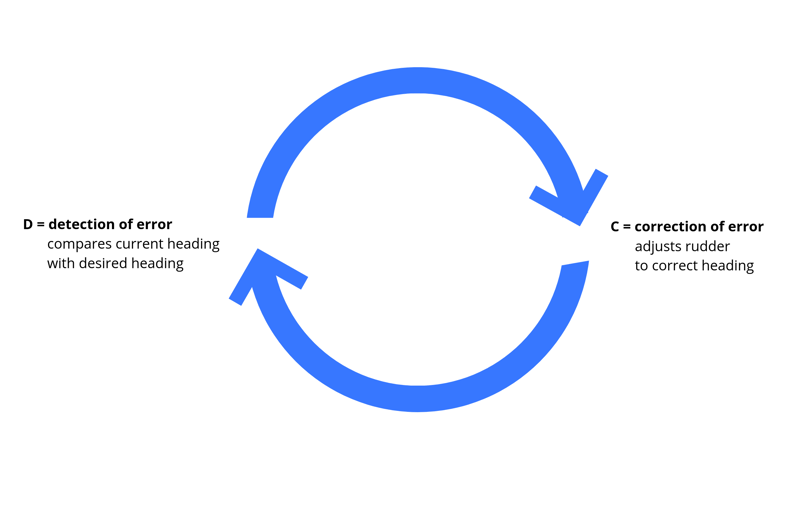
And in turn will steer a path like the one below...
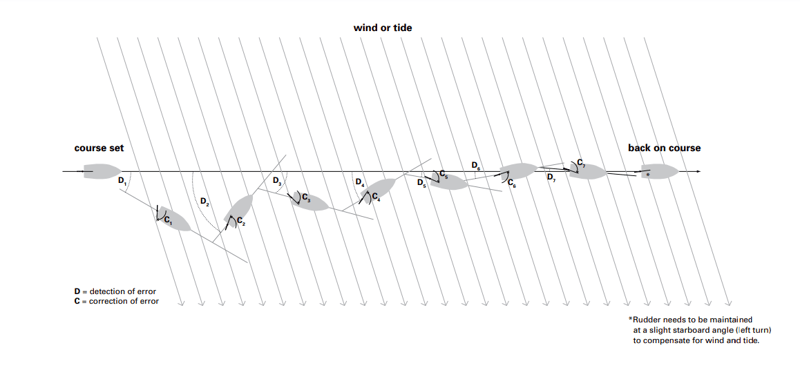
Take a moment to look at how the boat adjusts ‘where it is pointed’ the minimum amount of times necessary in order to ‘get back on course’. The adjustments are small, and perfect in this example.
What then is ‘Digital Cybernetics for Business’?
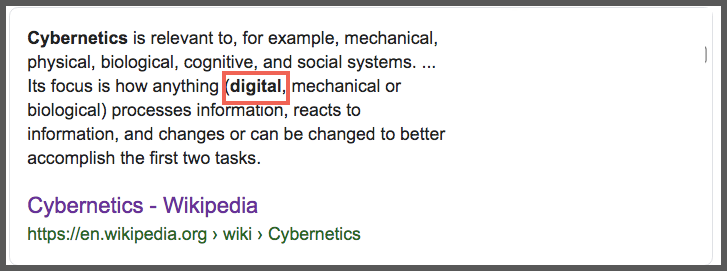
Stafford Beer (who brought cybernetics to ‘management’) says that cybernetics is "The art of effective organization.” This is in large part why I am focused on ‘Organisation’ (or ‘Organization) being fundamental to the process of installing systems that can, and do, more effectively ‘talk to each other’.
I want to be very specific in my application of Cybernetics - knowing the breadth and depth of the subject, and my somewhat narrow focus on looking at how to more effectively Organise and Optimise businesses using Digital Tools.
Seeing as just about all businesses now use such tools, and that there are (literally) hundreds of thousands of these tools available, it still gives us enough room for manoeuvre.
The problem that Digital Cybernetics for Business is seeking to address comes from my 20 years experience as a Consultant, and is this: most business systems don’t ‘talk to each other’, let alone ‘inform’ each other what needs to change in order to achieve organisational goals.
That is, until now.
The digital world has transformed our ability to ‘connect the dots’ between e.g. initial point of contact via a Search Engine query, all the way through to them becoming a customer.
And the opportunity for business right now (whether small or large) in 2019, is to set goals, organise their resources, create experiments, and then measure their effectiveness, before assessing how close they get to their original goal. In other words, people are learning ‘The Art of Steering’, but may not have the best conceptual models to help them reach their GOALS, let alone ‘connected systems’ that allow for intelligence automation.
What Digital Cybernetics is not...
This has nothing to do with ‘coding’, so don’t worry if that ‘scares you’. This is about applying ‘a way to think’ about YOUR business that will give you actionable points to generate real change.
Cybernetics and Systems Thinking
You may well see a similarity with Systems Thinking, and you’d be right to see a relationship.
Barry Clemson addresses this one perfectly when he says: Cybernetics can be characterized as the science of systems thinking. Mechanistic thinking is “machine like” and systems thinking is ecological. Linear thinking focuses on linear chains of causality and systems thinking focuses on circles of causality.
And ‘Britannica’ says:
Cybernetics, control theory as it is applied to complex systems. Cybernetics is associated with models in which a monitor compares what is happening to a system at various sampling times with some standard of what should be happening, and a controller adjusts the system’s behaviour accordingly.
As such, sometimes there may well be an overlap in both language and use of both ‘cybernetics’ and ‘systems thinking’ in this series of articles.
Let’s get started by looking a little more at ‘feedback’.
What is feedback?
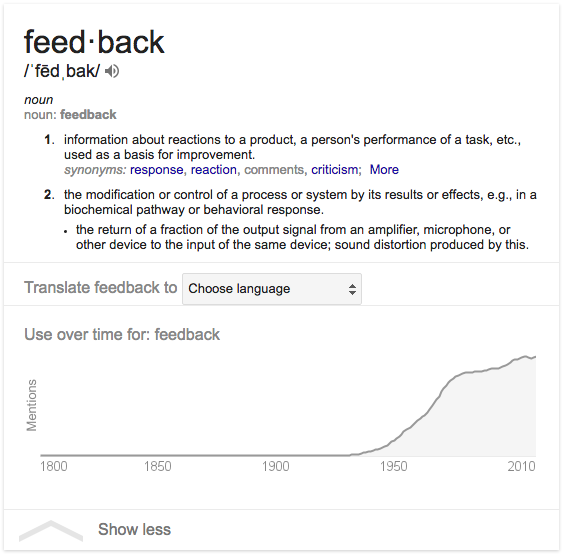
Feedback occurs when outputs of a system are routed back as inputs as part of a chain of cause-and-effect that forms a circuit or loop. (source)
Feedback was a word that sprang forth in the middle of the twentieth century, with authors like Stafford Beer writing on the subject of Cybernetics, which in turn became the base to much conversation on ‘Systems thinking’.
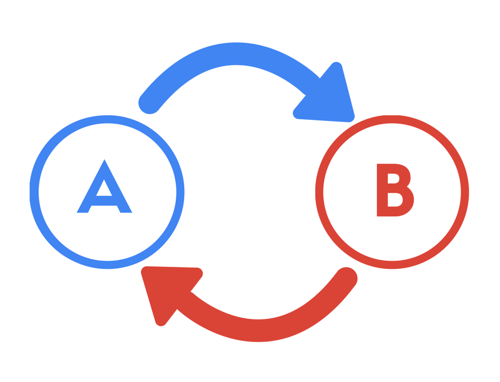
One example (of a reinforcing loop - which we will come to) is how A) when the global population is larger, B) people have more kids, which leads to A) the population becoming larger, which leads to B)...and so on.
In business, A) the more word of mouth a product gets, the more B) people buy it, which leads to more A) word of mouth, which leads to B)...
The thing to remember is that now, ‘word of mouth’ is as much a digital phenomenon as it is ‘real world’. And seeing as it is ‘digital’ it is far easier to track and trace every element that is generating the influence.
“The study and use of feedback was one of the major goals of the field of cybernetics in the 1950s as part of the understanding of control and regulation (homeostasis) in artificial and biological systems. The field of cybernetics was built on the work of Norbert Wiener. It focused on various aspects of feedback, and the role that feedback plays in a system's response to the environment. For example, automated machines require feedback to pursue goal-directed activities.” Source.
Let’s take a moment to look at this sentence a little more, “...automated machines require feedback to pursue goal-directed activities”.
Think about the systems you have in place in your business - are they Goal based? And how would you know?
This has to be a fundamental issue - we are attempting to ‘automate’ our business processes even more, but unless they have ‘Goals’ how do you know if they are ‘working’? I mean, how can you ‘steer’ if you don’t know whether adjustments you are making are getting you closer (or further away) from your goals - i.e. without suitable feedback loops you cannot steer toward a goal.
You may want you business to be run by Machine Learning, but being realistic, you are the one that’s at the helm most of the time, adjusting the course.
Positive Feedback and Negative Feedback
Just to clarify, positive feedback is otherwise known as a ‘reinforcing loop’, and negative feedback is a ‘balancing loop’.
Positive feedback is what can lead to exponential growth e.g. a few rabbits breed to have more rabbits, which have more rabbits (assuming they are left ‘unchecked’). Negative feedback (as we will discuss below) is like the ‘steering’ example you read earlier - where small adjustments ‘at the helm’ can change course, and move you toward a goal.
An example: The Thermostat
This is probably my favourite example of how to think about feedback loops - especially as it should bridge the gap to application in your business.
This is how a Thermostat can be illustrated as a Cybernetic Loop:
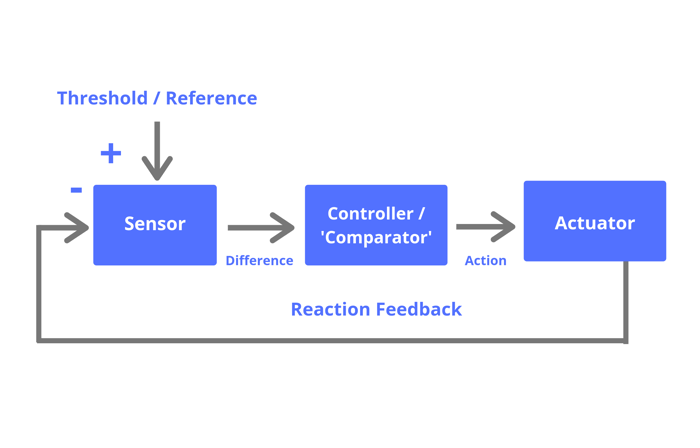
Based on image from this source.
So, how does a thermostat work? Well https://necsi.edu/feedback has a great explanation as follows...
“Feedback is a circular process of influence where action has effect on the actor. For example, a thermostat that controls the temperature in a house uses feedback. It contains a controller that turns the furnace on and off which heats the room. The thermostat also measures the temperature in the room to determine when to turn the furnace on and off. The control of the furnace changes the temperature in the room, which is measured by the thermostat which controls the temperature. The goal, in this case, is a reasonably uniform temperature which is specified by the position of the temperature dial.”
Taking it further, the process below shows you an essential element: the gap between GOAL and ‘actual performance’.
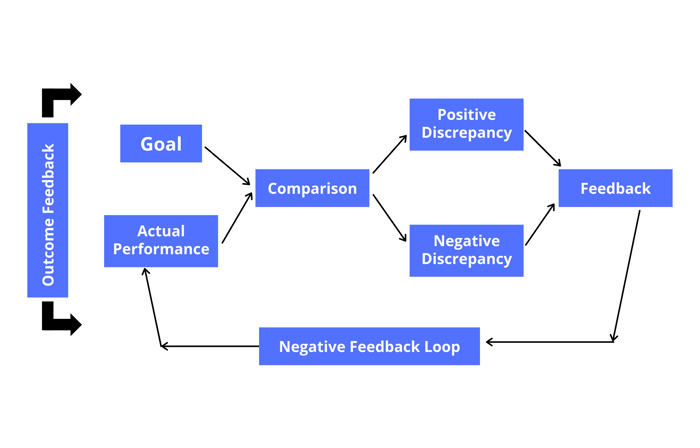
Seeing as we’ve now brought in the concept of ‘GOALS’, let’s ask...
How does this relate to the GROW model?
For those of you who have read my article (or seen the videos) on GROW, including this one on building faster momentum, it may be useful to show how that model is in fact based on cybernetic principles, and could be shown as follows:
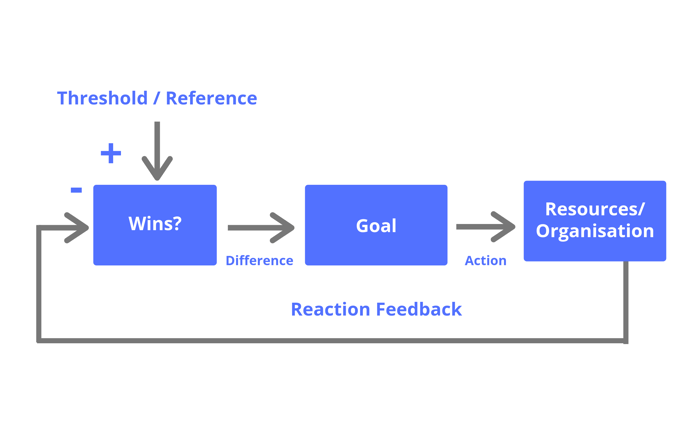
It just happens that the GROW model is a really easy starting point to a subject that can be somewhat more technical, as you will see later in this article.
For now, let’s break down each element...
Sensor/controller/actuator of the cybernetic loop
The use of a consistent language system will help us apply these principles into the digital business realm (and beyond).
As such, as you’ll see from the video below, we can describe the fundamental components to any control mechanism in terms of the following 3 terms:
Sensor - feeds information into the system. A sensor “is a component that detects and encodes some stimulus from the system’s environment and transfers it to the controller. Any given sensor can of course, only sense a specific stimulus. A sensor has a physical device that is receptive to some change in a parameter that it is measuring, with this change in stimulus then being encoded into information and transferred ultimately to the controller.”
Controller (otherwise known as a ‘Comparator’) - this “contains the logic, or set of instructions for processing this information. The controller is the brains of the operation. It contains the critical logic that is governing the whole system and is encoded in some set of instructions. The controller can be modeled as an information-processing unit taking in some input of information, manipulating this information according to its set of instructions with the result being an output of information that is designed to be acted upon.
Actuator - this “executes an action to affect the state of the system.” And can be defined as “an instrument or set of instruments that act on the instructions produced by the controller. It is designed to physically affect the system that is being regulated in order for it to conform with the instructions produced by the controller.”
|
|
Now that we have ‘the language’ it will make it much easier for you to consider:
what is the Sensor,
what (or ‘who’, see below) is the Controller/Comparator, and
what is the Actuator - in any given system.
And when they are ‘not there’, is there an opportunity to better achieve your goals, and the associated goals of the system, by building them in?
Let’s return to Pangaro’s work, and look at what happens when you add a GOAL to the loop.
Note: The source document which is really worth diving into, and I give full credit to his approach.
As you can see, we’ve now got a GOAL added to the top of the process.
And it is the GOAL that is ‘embodied’ (a key principle to note) into the Comparator itself...
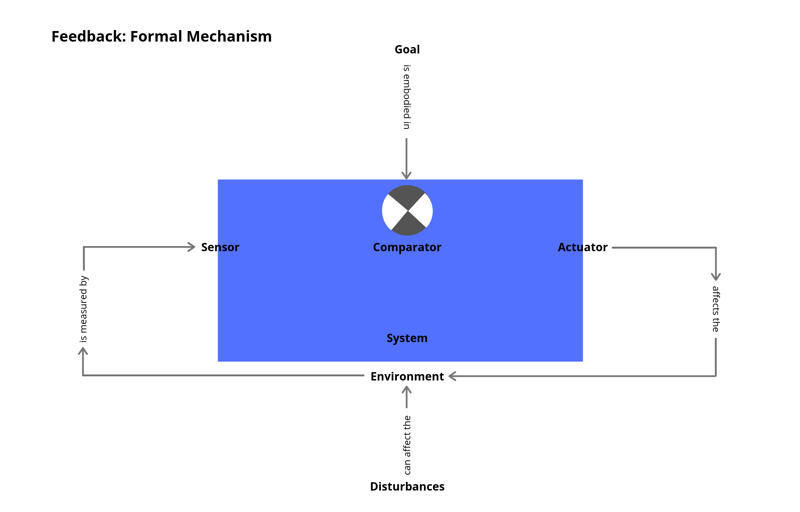
Let’s add in a little more of Pangaro’s text to explain the process:
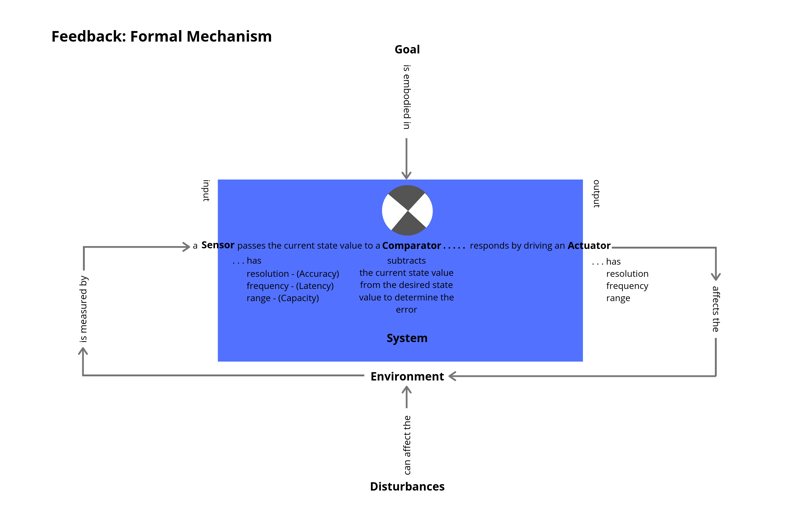
I want to draw your attention to the process in simple terms:
The sensor gives information on ‘the current state’. Then, “the comparator subtracts the current state value from the desired state value to determine the error”. Before the actuator ‘acts’ upon the environment, before the Sensor once more senses. The attempt in this system, therefore, is to Close the Gap between the current state and the desired state.
Let’s return to the Thermostat to really hit home how this process works:
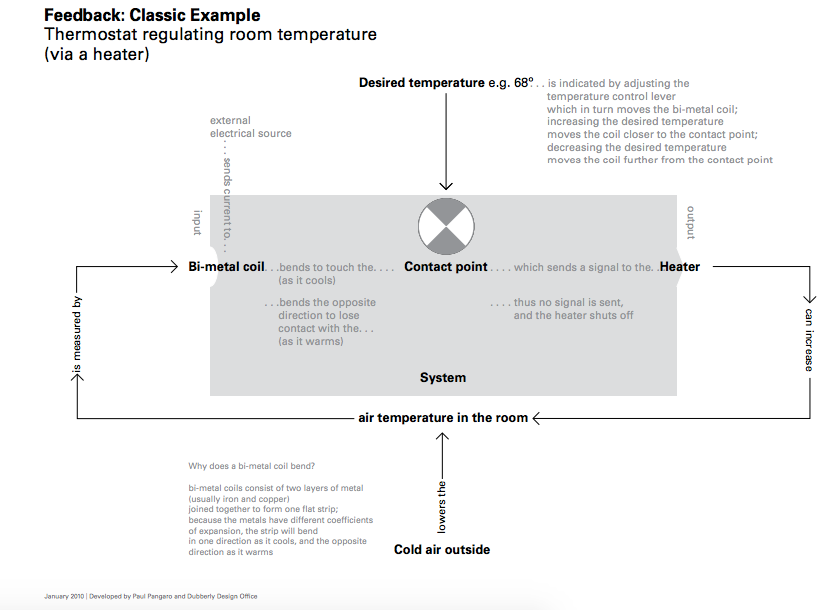
Note: I’ve recreated these images to help with the clarity of the text. Originals are here. As he says,
“The goal of a Desired temperature of 68F is set by the human. This enables a comparator function, in the form of the relationship between the Contact point and the Bi-metal coil which reflects the current temperature of the air in the room. (The next model gives an example of exactly how the comparator might work.) If the Contact point closes a circuit, indicating that the temperature of the room is too low compared to the Desired temperature, the Heater is turned on. Over time this should raise the air temperature in the room, which will be sensed by the Bi-metal coil, in turn causing movement of the Contact point.”
Now, here is the thing…
There is a human operator involved in this process - a system that is controlling a system, as such we need to move from what is known as ‘First-order feedback’ into ‘Second-order feedback.’
Second-order Feedback: Formal Mechanism
Staying with Pangaro, we see “an automatic feedback system (first-order) is controlled by another automatic feedback system (second-order). The first system is ‘nested’ inside the second.”
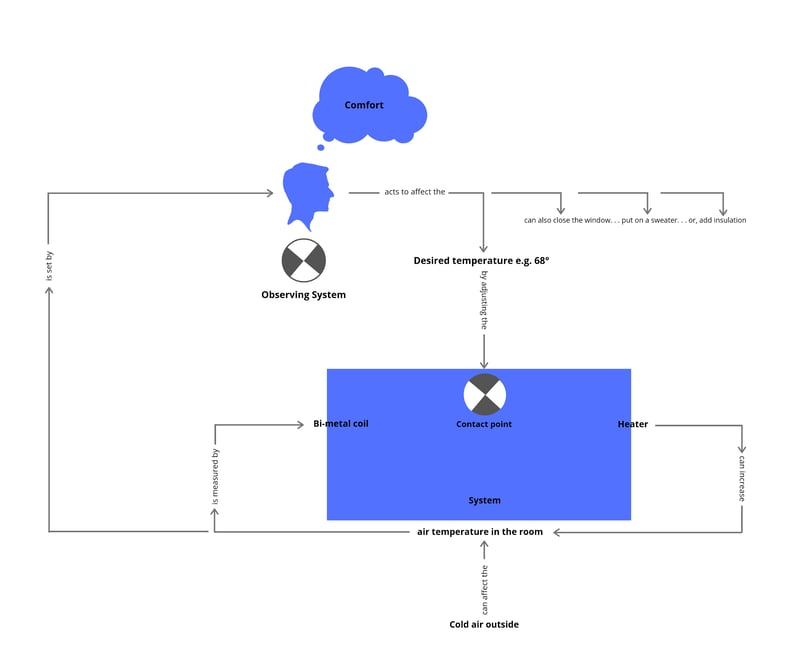
Note that the person is driving the outcome i.e. too warm, or too cold, with an outcome of ‘comfort’. But as well as their ability to ‘turn the dial’ on the Comparator they could also a) open a window, b) put on a sweater, or c) add insulation.
In other words, it is the GOALS of people operating the various aspects of the system that will also determine whether the overall system ‘works’ in changing the temperature.
Let’s say everyone in the office is ‘too cold’, but Brian (it’s always Brian) decides than instead of ‘turning the dial’ he will put on a sweater - what is the result? Other people’s comfort level is not changed.
Alternatively, if there is an agreement that the GOAL for the office temperature is 5 degrees higher than the current level, then Brian’s action of putting on a jumper will not affect that GOAL, hence his decision to ‘turn the dial’ with the intent of increasing the office temperature.
This idea that there is a ‘dial to be turned’ is precisely where I want us to go next, before we wrap up this introduction. And to do this, we shall consider the application within ‘Digital Marketing’.
Cybernetics and Digital Marketing
I would suggest that many professional marketers are already thinking in terms of cybernetics, even if they ‘don’t have the language’.
Returning to our three principles of the basic cybernetic loop...
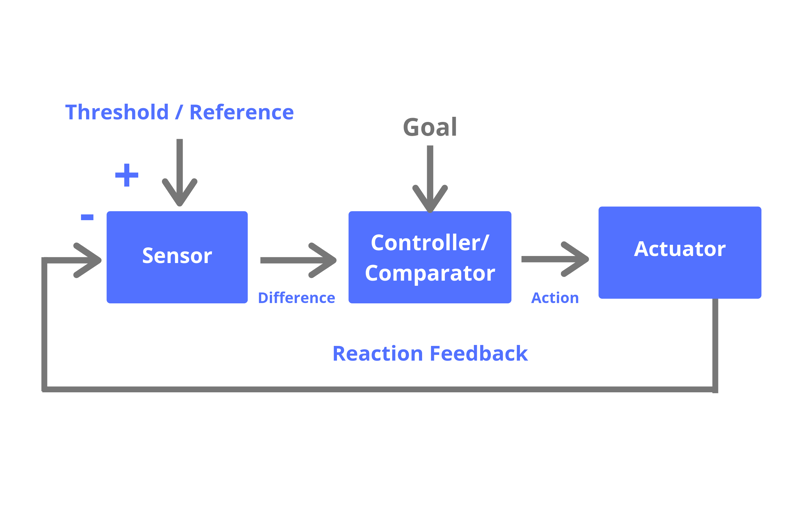
...we can begin to overlay the model into our real world experience.
We have:
A Sensor
A Controller/Comparator, and
An Actuator
With the additional element of a GOAL - seeing as we are considering goal based systems.
Starting with GOAL…
The GOAL of digital marketing, most often, is the following:
To generate as many new customers, at a CAC (= Cost of Acquiring a Customer) as the business can service.
So to begin, you need to make sure you are very clear on:
How much does it cost to acquire a new customer?
(including all ‘hidden costs’)
More on setting your marketing goals here.
Then, let’s start at the left and work to the right on the loop:
In terms of ‘Sensors’, we have numerous indicators we could ‘watch’, including:
- Open rates of emails
- Clicks on links
- Clicks on ads
- Conversions
- Cost of conversion
- Volumes of leads
- Volume of customers
- And so on.
But ultimately CAC (Cost of Acquiring a Customer) is the indicator we should start with.
This will have a threshold of what is tolerable, and what is not, for each business.
In terms of Controllers/Comparators, you can then look at ‘turning up (or down) the dial i.e. increase (or reduce) resources, including:
- Total budget on any given activity
- Cost per click bid
- Staff allocation
- Volume of activities to be undertaken
- etc
Then, based upon this ‘intent’, the Actuators will start the process i.e.
More ‘energy’ is put into the system.
The reality is, this ‘energy’ always boils down to ‘money’, hence the need to focus on CAC as the primary metric - BUT it absolutely depends a) upon what systems you are using, b) how connected your systems are to each other, and c) how effectively they are ‘set up’.
Using Adwords to show a very basic example, here is how it tends to work:
The goal is £1000 Cost of Acquisition of a New Customer
The Comparator then sets the intent of e.g. 30 new customers a month at this price
The digital infrastructure is the Actuator, with:
Adwords activated, with a suitable bid price to get relevant clicks
A landing page receives the traffic, and some people are converted into enquiries
A sales person then responds
And a person buys
The Sensor is then observed as to the actual Cost of Acquisition, as opposed to the ‘GOAL’ of £1000
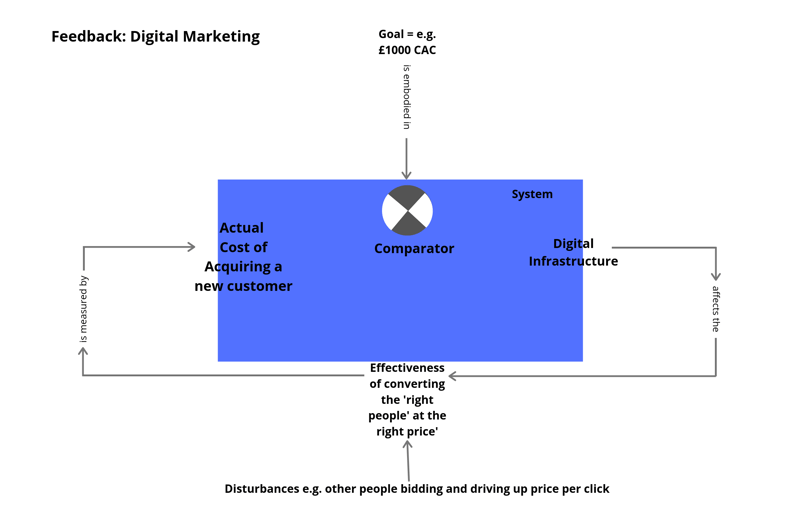
Note: there are many, many more factors and variables to be considered in the model, and other processes that can be employed (e.g. using remarketing/retargeting to re-engage and drop the overall Average CAC) - but we have to start somewhere).
There is, however, a major systems issue people are facing right now.
I’ve been using, and teaching, the principles of Pay-Per-Click advertising since I discovered ‘Overture’ in 1999 (bought by Yahoo).
The dream for many businesses is to be able to ‘put marketing spend in one end’ of the system and have 400%+ ROI come out the other. And PPC has this promise. The problem is for companies that don’t have an e-commerce business (i.e. one where the sale happens ‘on their website’ e.g through a store). Being more specific, the issue is for companies that use Adwords to generate ‘leads’ that are then progressed through a number of touchpoints, often relationally through interactions with team members, to a point of them purchasing - and often purchasing via the phone, with an invoice being sent to their finance department.
Note: I am using Adwords as the example, but the principles apply to Facebook ads, LinkedIn, Instagram etc.
It is also the case when looking at referrals, organic traffic, ‘direct’ to your site, social media and so on...
This is not only an issue for B2B sales though. Our case study over 3 years was built through a mix of B2B and B2C sales, and of which 98% came from ‘non-website’ purchases.
In short, the issue is one of ‘attribution’ i.e. which source(s) should be given credit for the sale.
If you have a marketing department, go and ask them this question:
Can you tell me the ROI from our Adwords campaigns (or other digital spend)?
Without knowing this, you are operating blindly as to which ‘leads’, from which keywords, are generating your customers (and therefore your revenue). You are probably wasting 50% of your adspend, you just don’t know which 50%. (credit to John Wanamaker)
I’ve been saying this for a while: How HubSpot can transform Adwords Ad attribution, from 2016
This reason alone was why myself and Elisa have committed to promoting HubSpot as the solution for businesses wanting to grow. You can see the ROI directly within the platform as it closes the loop between source and customer:

All of the things you say you want in relation to marketing - transparency, accountability and scalability are improved through a centralised database.
And aiming for 400% ROI is a good start:
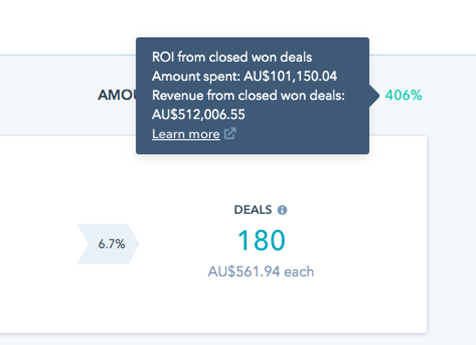
The reality is though, you may make some even bigger wins in terms of ROI, as you can see below:
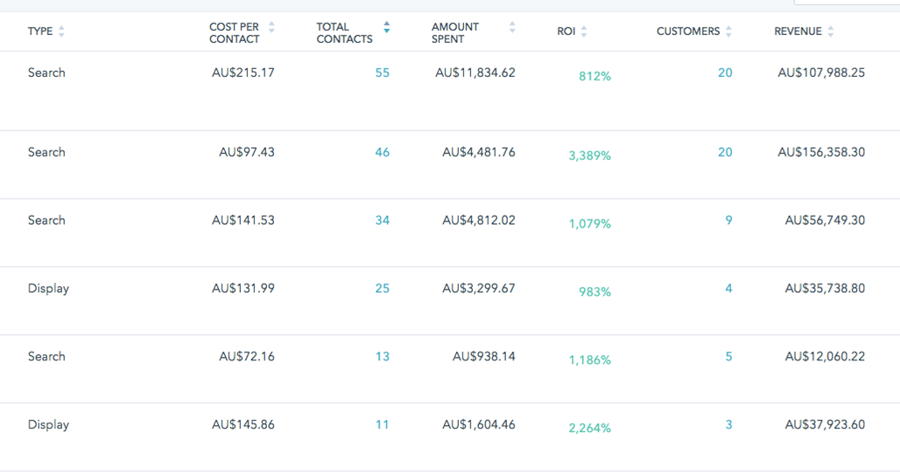
These are ‘real figures’ for the client from our case study - take a moment to peruse how less than $5000 turned into over $150,000. The reason? Application of the principles you’ve read so far.
And let me stress, this is not just about PPC. HubSpot connects the source of ALL your leads to the actual revenue generated when they become customers.
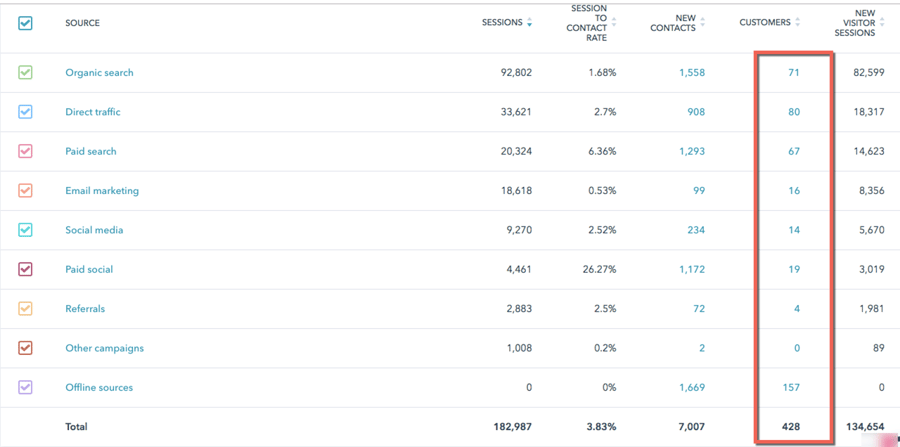
Even the information at this level will influence your understanding, and can alter your behaviour to drive more results.
“Martin and his team have been providing all of our company’s digital and social marketing for the last 2-3 years – They have developed a pragmatic and systemic design and integral approach to our business utilising our HubSpot marketing software and their own drive and determination for Marketing results!
Often operating and adding value to the business well beyond the marketing scope.”
Joseph Scott, CEO – The Coaching Room
As this stage of systems evolution, there is still very much a human element ‘at the helm’ e.g. when leads from a specific ad campaign are converting ‘well’, you still need to have a human move resources into this area, and away from underperforming areas of the business.
Eventually, we can assume, we’ll automate that process as well.
Finally...
Revisiting the concept of a simple feedback loop below, we can see (as is described by the source text), “A feedback loop where all outputs of a process are available as causal inputs to that process.”
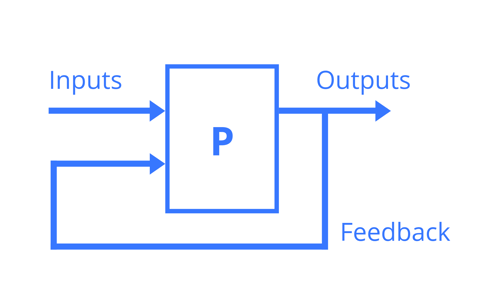
This is what we are trying to achieve - a way to alter ‘what we do’ based upon ‘what has happened’. Remember this simplicity as it will serve you well moving forward.
As you will have gathered, as an application of ‘Cybernetics’, Digital Cybernetics for Business is still a vast area to explore. My intent is to do my best at organising the information in a way that will allow the complexity of your internal business systems to be a) understand better, and b) more in your control.
To recap: your business should have one main marketing GOAL - to acquire (sufficient) customers at a targeted Cost Acquisition Customer (CAC)
This, more than anything, should be the purpose of the system - and if you have this in mind at all times when you are tracking the success of campaigns, then you will stay on track.
The promise I mentioned at the start was: Digital Cybernetics for Business - How to Automate Your Business Processes and Increase Profitability
Hopefully you can now see there is a need to organise your business in a way that enables the optimisation process to be effective. ‘Automation’ of admin tasks will almost certainly and directly ‘save you money’, but there is much more it can do for you when intelligent systems are informing your decisions, or even (in time) making those decisions for you.
And I know, as we reach the end of this Introduction, you’ll may feel...‘all at sea’ as to what to do next. Don’t worry though, our aim is to help get you shipshape (organise) - which in turn will help you focus on being more confident at the helm (understanding/structure/processes), as you continue to progress with ‘The Art of Steering’ your business vehicle toward your goals (optimisation).
Special thanks to: Paul Pangaro’s influence, and especially this document.
Some resources used in this article:
https://kevinbinz.com/2016/01/13/cybernetics/
https://www.quora.com/What-is-cybernetics
https://commons.wikimedia.org/wiki/File:Cybernetic_Loop.jpg
https://www.britannica.com/science/cybernetics
http://www.barryclemson.net/dr-barry-clemson/systems-thinking/
https://www.sciencedirect.com/topics/computer-science/cybernetics
https://www.sciencedirect.com/topics/computer-science/cybernetics
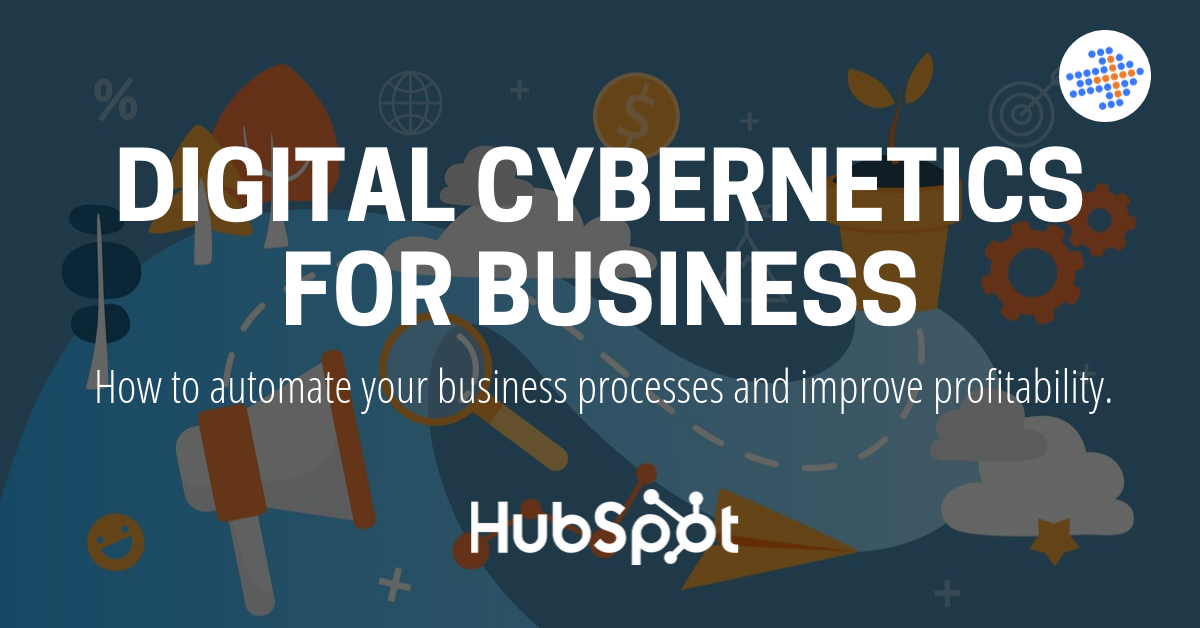
CONTENTS
Introduction
What is Cybernetics?
What then is ‘Digital Cybernetics for Business’?
Cybernetics and Systems Thinking
What is feedback?
Positive Feedback and Negative Feedback
An example: The Thermostat
How does this relate to the GROW model?
Sensor/controller/actuator of the cybernetic loop
Second-order Feedback: Formal Mechanism
Cybernetics and Digital Marketing
Finally...
Introduction
In my mid-20s I was introduced to the concept of Cybernetics (and Stafford Beer’s work in particular) by John Seymour, with whom I worked and wrote management books for over 10 years.
When I chatted with him about my work as an Organisational Consultant earlier this year, it became clear that there was a role for revisiting Cybernetics from a Digital Perspective. In that way, this article is a primer for an upcoming series of articles, videos and maybe even ‘conceptual games’ that all have the same common goal: to help your business grow through better ‘organisation’ and ‘optimisation’.
So, why have we partnered with HubSpot? The answer is simple - using HubSpot, we worked with one client, for three years, for thousands of hours - and along the way, I made notes. The result is a case study of all the processes we put in place, making it far quicker to now install the necessary structures and processes to grow a profitable business by 20%+ a year, using the latest technology.
As you will have seen, the image at the top of this article has a subtitle: ‘How to automate your business processes and improve profitability’
This is ultimately where we are going, and I will return and add many of the key automation processes we use. For now, though, let’s dive into a little more explanation as to the foundation principles we are going to cover, starting with...
What is Cybernetics?

Norbert Wiener defined cybernetics in 1948 as "the scientific study of control and communication in the animal and the machine."
Cybernetics comes from the from Greek word kubernētēs meaning ‘steersman’, from kubernan ‘to steer’.
You may like to think of it in terms of ‘the art of steering’, a phrase I picked up from Cybernetic writer and thinker extraordinaire, Paul Pangaro.
He describes cybernetics as “the most powerful language to describe systems that have goals”. Watch this to learn more...
What is cybernetics? from Paul Pangaro on Vimeo.
In short, cybernetics is a discipline for understanding how actions may lead to achieving goals. Knowing whether you have reached your goal (or at least are getting closer to it) requires "feedback", a concept that comes from cybernetics. "Cybernetics" evolved into Latin as "governor".
This idea of ‘steering’ is something to which you will probably relate.
Pangaro says, “Pilots rely on (negative) feedback to steer a system toward a goal”:

And in turn will steer a path like the one below...

Take a moment to look at how the boat adjusts ‘where it is pointed’ the minimum amount of times necessary in order to ‘get back on course’. The adjustments are small, and perfect in this example.
What then is ‘Digital Cybernetics for Business’?

Stafford Beer (who brought cybernetics to ‘management’) says that cybernetics is "The art of effective organization.” This is in large part why I am focused on ‘Organisation’ (or ‘Organization) being fundamental to the process of installing systems that can, and do, more effectively ‘talk to each other’.
I want to be very specific in my application of Cybernetics - knowing the breadth and depth of the subject, and my somewhat narrow focus on looking at how to more effectively Organise and Optimise businesses using Digital Tools.
Seeing as just about all businesses now use such tools, and that there are (literally) hundreds of thousands of these tools available, it still gives us enough room for manoeuvre.
The problem that Digital Cybernetics for Business is seeking to address comes from my 20 years experience as a Consultant, and is this: most business systems don’t ‘talk to each other’, let alone ‘inform’ each other what needs to change in order to achieve organisational goals.
That is, until now.
The digital world has transformed our ability to ‘connect the dots’ between e.g. initial point of contact via a Search Engine query, all the way through to them becoming a customer.
And the opportunity for business right now (whether small or large) in 2019, is to set goals, organise their resources, create experiments, and then measure their effectiveness, before assessing how close they get to their original goal. In other words, people are learning ‘The Art of Steering’, but may not have the best conceptual models to help them reach their GOALS, let alone ‘connected systems’ that allow for intelligence automation.
What Digital Cybernetics is not...
This has nothing to do with ‘coding’, so don’t worry if that ‘scares you’. This is about applying ‘a way to think’ about YOUR business that will give you actionable points to generate real change.
Cybernetics and Systems Thinking
You may well see a similarity with Systems Thinking, and you’d be right to see a relationship.
Barry Clemson addresses this one perfectly when he says: Cybernetics can be characterized as the science of systems thinking. Mechanistic thinking is “machine like” and systems thinking is ecological. Linear thinking focuses on linear chains of causality and systems thinking focuses on circles of causality.
And ‘Britannica’ says:
Cybernetics, control theory as it is applied to complex systems. Cybernetics is associated with models in which a monitor compares what is happening to a system at various sampling times with some standard of what should be happening, and a controller adjusts the system’s behaviour accordingly.
As such, sometimes there may well be an overlap in both language and use of both ‘cybernetics’ and ‘systems thinking’ in this series of articles.
Let’s get started by looking a little more at ‘feedback’.
What is feedback?

Feedback occurs when outputs of a system are routed back as inputs as part of a chain of cause-and-effect that forms a circuit or loop. (source)
Feedback was a word that sprang forth in the middle of the twentieth century, with authors like Stafford Beer writing on the subject of Cybernetics, which in turn became the base to much conversation on ‘Systems thinking’.

One example (of a reinforcing loop - which we will come to) is how A) when the global population is larger, B) people have more kids, which leads to A) the population becoming larger, which leads to B)...and so on.
In business, A) the more word of mouth a product gets, the more B) people buy it, which leads to more A) word of mouth, which leads to B)...
The thing to remember is that now, ‘word of mouth’ is as much a digital phenomenon as it is ‘real world’. And seeing as it is ‘digital’ it is far easier to track and trace every element that is generating the influence.
“The study and use of feedback was one of the major goals of the field of cybernetics in the 1950s as part of the understanding of control and regulation (homeostasis) in artificial and biological systems. The field of cybernetics was built on the work of Norbert Wiener. It focused on various aspects of feedback, and the role that feedback plays in a system's response to the environment. For example, automated machines require feedback to pursue goal-directed activities.” Source.
Let’s take a moment to look at this sentence a little more, “...automated machines require feedback to pursue goal-directed activities”.
Think about the systems you have in place in your business - are they Goal based? And how would you know?
This has to be a fundamental issue - we are attempting to ‘automate’ our business processes even more, but unless they have ‘Goals’ how do you know if they are ‘working’? I mean, how can you ‘steer’ if you don’t know whether adjustments you are making are getting you closer (or further away) from your goals - i.e. without suitable feedback loops you cannot steer toward a goal.
You may want you business to be run by Machine Learning, but being realistic, you are the one that’s at the helm most of the time, adjusting the course.
Positive Feedback and Negative Feedback
Just to clarify, positive feedback is otherwise known as a ‘reinforcing loop’, and negative feedback is a ‘balancing loop’.
Positive feedback is what can lead to exponential growth e.g. a few rabbits breed to have more rabbits, which have more rabbits (assuming they are left ‘unchecked’). Negative feedback (as we will discuss below) is like the ‘steering’ example you read earlier - where small adjustments ‘at the helm’ can change course, and move you toward a goal.
An example: The Thermostat
This is probably my favourite example of how to think about feedback loops - especially as it should bridge the gap to application in your business.
This is how a Thermostat can be illustrated as a Cybernetic Loop:

Based on image from this source.
So, how does a thermostat work? Well https://necsi.edu/feedback has a great explanation as follows...
“Feedback is a circular process of influence where action has effect on the actor. For example, a thermostat that controls the temperature in a house uses feedback. It contains a controller that turns the furnace on and off which heats the room. The thermostat also measures the temperature in the room to determine when to turn the furnace on and off. The control of the furnace changes the temperature in the room, which is measured by the thermostat which controls the temperature. The goal, in this case, is a reasonably uniform temperature which is specified by the position of the temperature dial.”
Taking it further, the process below shows you an essential element: the gap between GOAL and ‘actual performance’.

Seeing as we’ve now brought in the concept of ‘GOALS’, let’s ask...
How does this relate to the GROW model?
For those of you who have read my article (or seen the videos) on GROW, including this one on building faster momentum, it may be useful to show how that model is in fact based on cybernetic principles, and could be shown as follows:

It just happens that the GROW model is a really easy starting point to a subject that can be somewhat more technical, as you will see later in this article.
For now, let’s break down each element...
Sensor/controller/actuator of the cybernetic loop
The use of a consistent language system will help us apply these principles into the digital business realm (and beyond).
As such, as you’ll see from the video below, we can describe the fundamental components to any control mechanism in terms of the following 3 terms:
Sensor - feeds information into the system. A sensor “is a component that detects and encodes some stimulus from the system’s environment and transfers it to the controller. Any given sensor can of course, only sense a specific stimulus. A sensor has a physical device that is receptive to some change in a parameter that it is measuring, with this change in stimulus then being encoded into information and transferred ultimately to the controller.”
Controller (otherwise known as a ‘Comparator’) - this “contains the logic, or set of instructions for processing this information. The controller is the brains of the operation. It contains the critical logic that is governing the whole system and is encoded in some set of instructions. The controller can be modeled as an information-processing unit taking in some input of information, manipulating this information according to its set of instructions with the result being an output of information that is designed to be acted upon.
Actuator - this “executes an action to affect the state of the system.” And can be defined as “an instrument or set of instruments that act on the instructions produced by the controller. It is designed to physically affect the system that is being regulated in order for it to conform with the instructions produced by the controller.”
|
|
Now that we have ‘the language’ it will make it much easier for you to consider:
what is the Sensor,
what (or ‘who’, see below) is the Controller/Comparator, and
what is the Actuator - in any given system.
And when they are ‘not there’, is there an opportunity to better achieve your goals, and the associated goals of the system, by building them in?
Let’s return to Pangaro’s work, and look at what happens when you add a GOAL to the loop.
Note: The source document which is really worth diving into, and I give full credit to his approach.
As you can see, we’ve now got a GOAL added to the top of the process.
And it is the GOAL that is ‘embodied’ (a key principle to note) into the Comparator itself...

Let’s add in a little more of Pangaro’s text to explain the process:

I want to draw your attention to the process in simple terms:
The sensor gives information on ‘the current state’. Then, “the comparator subtracts the current state value from the desired state value to determine the error”. Before the actuator ‘acts’ upon the environment, before the Sensor once more senses. The attempt in this system, therefore, is to Close the Gap between the current state and the desired state.
Let’s return to the Thermostat to really hit home how this process works:

Note: I’ve recreated these images to help with the clarity of the text. Originals are here. As he says,
“The goal of a Desired temperature of 68F is set by the human. This enables a comparator function, in the form of the relationship between the Contact point and the Bi-metal coil which reflects the current temperature of the air in the room. (The next model gives an example of exactly how the comparator might work.) If the Contact point closes a circuit, indicating that the temperature of the room is too low compared to the Desired temperature, the Heater is turned on. Over time this should raise the air temperature in the room, which will be sensed by the Bi-metal coil, in turn causing movement of the Contact point.”
Now, here is the thing…
There is a human operator involved in this process - a system that is controlling a system, as such we need to move from what is known as ‘First-order feedback’ into ‘Second-order feedback.’
Second-order Feedback: Formal Mechanism
Staying with Pangaro, we see “an automatic feedback system (first-order) is controlled by another automatic feedback system (second-order). The first system is ‘nested’ inside the second.”

Note that the person is driving the outcome i.e. too warm, or too cold, with an outcome of ‘comfort’. But as well as their ability to ‘turn the dial’ on the Comparator they could also a) open a window, b) put on a sweater, or c) add insulation.
In other words, it is the GOALS of people operating the various aspects of the system that will also determine whether the overall system ‘works’ in changing the temperature.
Let’s say everyone in the office is ‘too cold’, but Brian (it’s always Brian) decides than instead of ‘turning the dial’ he will put on a sweater - what is the result? Other people’s comfort level is not changed.
Alternatively, if there is an agreement that the GOAL for the office temperature is 5 degrees higher than the current level, then Brian’s action of putting on a jumper will not affect that GOAL, hence his decision to ‘turn the dial’ with the intent of increasing the office temperature.
This idea that there is a ‘dial to be turned’ is precisely where I want us to go next, before we wrap up this introduction. And to do this, we shall consider the application within ‘Digital Marketing’.
Cybernetics and Digital Marketing
I would suggest that many professional marketers are already thinking in terms of cybernetics, even if they ‘don’t have the language’.
Returning to our three principles of the basic cybernetic loop...

...we can begin to overlay the model into our real world experience.
We have:
A Sensor
A Controller/Comparator, and
An Actuator
With the additional element of a GOAL - seeing as we are considering goal based systems.
Starting with GOAL…
The GOAL of digital marketing, most often, is the following:
To generate as many new customers, at a CAC (= Cost of Acquiring a Customer) as the business can service.
So to begin, you need to make sure you are very clear on:
How much does it cost to acquire a new customer?
(including all ‘hidden costs’)
More on setting your marketing goals here.
Then, let’s start at the left and work to the right on the loop:
In terms of ‘Sensors’, we have numerous indicators we could ‘watch’, including:
- Open rates of emails
- Clicks on links
- Clicks on ads
- Conversions
- Cost of conversion
- Volumes of leads
- Volume of customers
- And so on.
But ultimately CAC (Cost of Acquiring a Customer) is the indicator we should start with.
This will have a threshold of what is tolerable, and what is not, for each business.
In terms of Controllers/Comparators, you can then look at ‘turning up (or down) the dial i.e. increase (or reduce) resources, including:
- Total budget on any given activity
- Cost per click bid
- Staff allocation
- Volume of activities to be undertaken
- etc
Then, based upon this ‘intent’, the Actuators will start the process i.e.
More ‘energy’ is put into the system.
The reality is, this ‘energy’ always boils down to ‘money’, hence the need to focus on CAC as the primary metric - BUT it absolutely depends a) upon what systems you are using, b) how connected your systems are to each other, and c) how effectively they are ‘set up’.
Using Adwords to show a very basic example, here is how it tends to work:
The goal is £1000 Cost of Acquisition of a New Customer
The Comparator then sets the intent of e.g. 30 new customers a month at this price
The digital infrastructure is the Actuator, with:
Adwords activated, with a suitable bid price to get relevant clicks
A landing page receives the traffic, and some people are converted into enquiries
A sales person then responds
And a person buys
The Sensor is then observed as to the actual Cost of Acquisition, as opposed to the ‘GOAL’ of £1000

Note: there are many, many more factors and variables to be considered in the model, and other processes that can be employed (e.g. using remarketing/retargeting to re-engage and drop the overall Average CAC) - but we have to start somewhere).
There is, however, a major systems issue people are facing right now.
I’ve been using, and teaching, the principles of Pay-Per-Click advertising since I discovered ‘Overture’ in 1999 (bought by Yahoo).
The dream for many businesses is to be able to ‘put marketing spend in one end’ of the system and have 400%+ ROI come out the other. And PPC has this promise. The problem is for companies that don’t have an e-commerce business (i.e. one where the sale happens ‘on their website’ e.g through a store). Being more specific, the issue is for companies that use Adwords to generate ‘leads’ that are then progressed through a number of touchpoints, often relationally through interactions with team members, to a point of them purchasing - and often purchasing via the phone, with an invoice being sent to their finance department.
Note: I am using Adwords as the example, but the principles apply to Facebook ads, LinkedIn, Instagram etc.
It is also the case when looking at referrals, organic traffic, ‘direct’ to your site, social media and so on...
This is not only an issue for B2B sales though. Our case study over 3 years was built through a mix of B2B and B2C sales, and of which 98% came from ‘non-website’ purchases.
In short, the issue is one of ‘attribution’ i.e. which source(s) should be given credit for the sale.
If you have a marketing department, go and ask them this question:
Can you tell me the ROI from our Adwords campaigns (or other digital spend)?
Without knowing this, you are operating blindly as to which ‘leads’, from which keywords, are generating your customers (and therefore your revenue). You are probably wasting 50% of your adspend, you just don’t know which 50%. (credit to John Wanamaker)
I’ve been saying this for a while: How HubSpot can transform Adwords Ad attribution, from 2016
This reason alone was why myself and Elisa have committed to promoting HubSpot as the solution for businesses wanting to grow. You can see the ROI directly within the platform as it closes the loop between source and customer:

All of the things you say you want in relation to marketing - transparency, accountability and scalability are improved through a centralised database.
And aiming for 400% ROI is a good start:

The reality is though, you may make some even bigger wins in terms of ROI, as you can see below:

These are ‘real figures’ for the client from our case study - take a moment to peruse how less than $5000 turned into over $150,000. The reason? Application of the principles you’ve read so far.
And let me stress, this is not just about PPC. HubSpot connects the source of ALL your leads to the actual revenue generated when they become customers.

Even the information at this level will influence your understanding, and can alter your behaviour to drive more results.
“Martin and his team have been providing all of our company’s digital and social marketing for the last 2-3 years – They have developed a pragmatic and systemic design and integral approach to our business utilising our HubSpot marketing software and their own drive and determination for Marketing results!
Often operating and adding value to the business well beyond the marketing scope.”
Joseph Scott, CEO – The Coaching Room
As this stage of systems evolution, there is still very much a human element ‘at the helm’ e.g. when leads from a specific ad campaign are converting ‘well’, you still need to have a human move resources into this area, and away from underperforming areas of the business.
Eventually, we can assume, we’ll automate that process as well.
Finally...
Revisiting the concept of a simple feedback loop below, we can see (as is described by the source text), “A feedback loop where all outputs of a process are available as causal inputs to that process.”

This is what we are trying to achieve - a way to alter ‘what we do’ based upon ‘what has happened’. Remember this simplicity as it will serve you well moving forward.
As you will have gathered, as an application of ‘Cybernetics’, Digital Cybernetics for Business is still a vast area to explore. My intent is to do my best at organising the information in a way that will allow the complexity of your internal business systems to be a) understand better, and b) more in your control.
To recap: your business should have one main marketing GOAL - to acquire (sufficient) customers at a targeted Cost Acquisition Customer (CAC)
This, more than anything, should be the purpose of the system - and if you have this in mind at all times when you are tracking the success of campaigns, then you will stay on track.
The promise I mentioned at the start was: Digital Cybernetics for Business - How to Automate Your Business Processes and Increase Profitability
Hopefully you can now see there is a need to organise your business in a way that enables the optimisation process to be effective. ‘Automation’ of admin tasks will almost certainly and directly ‘save you money’, but there is much more it can do for you when intelligent systems are informing your decisions, or even (in time) making those decisions for you.
And I know, as we reach the end of this Introduction, you’ll may feel...‘all at sea’ as to what to do next. Don’t worry though, our aim is to help get you shipshape (organise) - which in turn will help you focus on being more confident at the helm (understanding/structure/processes), as you continue to progress with ‘The Art of Steering’ your business vehicle toward your goals (optimisation).
Special thanks to: Paul Pangaro’s influence, and especially this document.
Some resources used in this article:
https://kevinbinz.com/2016/01/13/cybernetics/
https://www.quora.com/What-is-cybernetics
https://commons.wikimedia.org/wiki/File:Cybernetic_Loop.jpg
https://www.britannica.com/science/cybernetics
http://www.barryclemson.net/dr-barry-clemson/systems-thinking/
https://www.sciencedirect.com/topics/computer-science/cybernetics
https://www.sciencedirect.com/topics/computer-science/cybernetics

